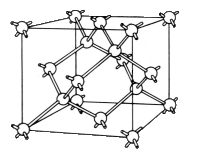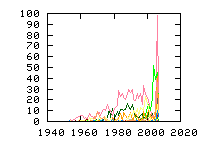« Previous
1
Next »
(17 hits, 1/1)
Showing
10, 25, 50, 100, 500, 1000, all papers per page.
Sort by:
last publication date,
older publication date,
last update date.
- 1. J. Appl. Phys. 94, 1 (2003) , “Negative bias temperature instability: Road to cross in deep submicron silicon semiconductor manufacturing”,We present an overview of negative bias temperature instability (NBTI) commonly observed in p-channel metal–oxide–semiconductor field-effect transistors when stressed with negative gate voltages at elevated temperatures. We discuss the results of such stress on device and circuit... (Read more)
- 2. J. Appl. Phys. 95, 4096 (2004) , “Nitridation effects on Pb center structures at SiO2/Si(100) interfaces ”,Interfacial defect structures of NO-nitride oxide on Si(100) were characterized by electron spin resonance spectroscopy. We confirmed that the effective g values of the Pb1 center are affected by interfacial nitridation even at a small nitrogen concentration of 5 at. %, while those of the Pb0 center proved to be unchanged. We observed that the shifted Pb1 line appeared gradually with interfacial nitrogen concentration, which suggests that the nitrogen-induced modified structure substitutes for the original Pb1 structure. Angular variations of the shifted Pb1 lines were also significantly different from those of pure oxide. Based on our analysis, we attributed the g value shift of the Pb1 center to dangling bond tilting, caused by the displacement of nearest-neighbor Si atoms. (Read more)
- 3. Microelectron. Reliability 45, 57 (2005) , “Characterization of interface defects related to negative-bias temperature instability SiON/Si<100> systems ”,Interface defects related to negative-bias temperature instability (NBTI) in an ultrathin plasma-nitrided SiON/ Si<100> system were characterized by using conductance–frequency measurements, electron-spin resonance measure- ments, and synchrotron radiation X-ray photoelectron spectroscopy. It was confirmed that NBTI is reduced by using D2-annealing instead of the usual H2-annealing. Interfacial Si dangling bonds (Pb1 and Pb0 centers) were detected in a sample subjected to negative-bias temperature stress (NBTS). Although we suggest that NBTS also generates non-Pb defects, it does not seem to generate nitrogen dangling bonds. These results show that NBTI of the plasma-nitrided SiON/Si system is predominantly due to Pb depassivation. Plasma nitridation was also found to increase the Pb1/Pb0 density ratio, modify the Pb1 defect structure, and increase the latent interface trap density by generating Si suboxides at the interface. These changes are likely to be the causes of NBTI in ultrathin plasma-nitrided SiON/Si systems. (Read more)
- 4. Appl. Phys. Lett. 82, 3677-3679 (2003) , “Interface defects responsible for negative-bias temperature instability in plasma-nitrided SiON/Si(100) systems”, Shinji Fujieda, Yoshinao Miura, and Motofumi SaitohInterface defects generated by negative-bias temperature stress (NBTS) in an ultrathin plasma- nitrided SiON/Si(100) system were characterized by using D2 annealing, conductance-frequency measurements, and electron-spin resonance measurements. D2 annealing was shown to lower... (Read more)
- 5. Phys. Rev. B 75, 144102 (2007) , “Theoretical investigation of nitrogen substitution in cubic zirconia”, Thomas BredowNitrogen substitution of oxygen ions in cubic zirconia was studied theoretically at density functional level. Nitrogen contents of 12.5 and 3.1% were studied with Zr8O16−mN2 and Zr32O64−mN2 supercells. For... (Read more)
- 6. Phys. Rev. Lett. 98, 026101 (2007) , “Bonding at the SiC-SiO2 Interface and the Effects of Nitrogen and Hydrogen”, Sanwu Wang, S. Dhar, Shu-rui Wang, A. C. Ahyi, A. Franceschetti, J. R. Williams, L. C. Feldman,, and Sokrates T. PantelidesUnlike the Si-SiO2 interface, the SiC-SiO2 interface has large defect densities. Though nitridation has been shown to reduce the defect density, the effect of H remains an open issue. Here we combine experimental data and the results of first-principles calculations to... (Read more)
- 7. Appl. Phys. Lett. 89, 152910 (2006) , “Characterization of atomic-layer-deposited Al2O3/GaAs interface improved by NH3 plasma pretreatment”, Hong-Liang Lu, Liang Sun, Shi-Jin Ding, Min Xu, David Wei Zhang, and Li-Kang WangAl2O3 thin films were deposited by atomic layer deposition on HF-cleaned and NH3 plasma-treated GaAs surfaces, respectively. The precursors used for Al2O3 films are trimethylaluminum and water. Effects of NH3 plasma pretreatment on... (Read more)
- 8. J. Appl. Phys. 99, 044105 (2006) , “Passivation of oxygen vacancy states in HfO2 by nitrogen”, K. Xiong, J. Robertson, and S. J. ClarkNitrogen is known to reduce leakage currents and charge trapping in high-dielectric-constant gate oxides such as HfO2. We show that this occurs because nitrogen, substituting for oxygen atoms next to oxygen vacancy sites, repels the occupied gap states due to the neutral and positively... (Read more)
- 9. Appl. Phys. Lett. 86, 143507 (2005) , “First-principles studies of the intrinsic effect of nitrogen atoms on reduction in gate leakage current through Hf-based high-k dielectrics”, N. Umezawa, K. Shiraishi, T. Ohno, H. Watanabe, T. Chikyow, K. Torii, K. Yamabe, K. Yamada, H. Kitajima, T. ArikadoThe atomistic effects of N atoms on the leakage current through HfO2 high-k gate dielectrics have been studied from first-principles calculations within the framework of a generalized gradient approximation (GGA). It has been found that the intrinsic effects of N atoms drastically... (Read more)
- 10. J. Appl. Phys. 97, 053704 (2005) , “The role of nitrogen-related defects in high-k dielectric oxides: Density-functional studies”, J. L. Gavartin, A. L. Shluger, A. S. Foster, G. I. BersukerUsing ab initio density-functional total energy and molecular-dynamics simulations, we study the effects of various forms of nitrogen postdeposition anneal (PDA) on the electric properties of hafnia in the context of its application as a gate dielectric in field-effect transistors. We... (Read more)
- 11. Appl. Phys. Lett. 81, 1818 (2002) , “Interface structures generated by negative-bias temperature instability in Si/SiO2 and Si/SiOxNy interfaces”, J. Ushio, T. Maruizumi, K. Kushida-AbdelghafarWe used a density functional method to investigate the mechanism of negative-bias temperature instability (NBTI) and resultant structural changes of Si/SiO2 and Si/SiOxNy interfaces. The reaction energies for the water- and hydrogen-originated... (Read more)
- 12. J. Vac. Sci. Technol. B 16, 2134-2153 (1998) , “What can electron paramagnetic resonance tell us about the Si/SiO2 system?”, P. M. Lenahan, J. F. Conley, Jr.Electron paramagnetic resonance (EPR) measurements of Si/SiO2 systems began over 30 years ago. Most EPR studies of Si/SiO2 systems have dealt with two families of defects: Pb centers and E centers. Several variants from each group have... (Read more)BPSG PSG Si SiO2| EDMR EPR electric-field-effect electrical-meas. etching gamma-irradiation| 10B 11B 1H 29Si 2D 31P BOHC Boron Deuterium E' E'-delta H(I) Hydrogen Nb Nitrogen Oxygen P1 P2 P4 POHC Pb Pb0 Pb1 Phosphorus Silicon amorphous complex(=3) dangling-bond device dielectric interface pair(=2) | last update: Takahide Umeda
- 13. Appl. Phys. Lett. 89, 053511 (2006) , “Density functional theory study of deep traps in silicon nitride memories”, Max Petersen and Yakov RoizinUsing density functional theory, the interaction of hydrogen with a nitrogen vacancy in -Si3N4 is investigated. A single H atom was found to be energetically favorable over non- and doubly protonated vacancies. The traps composed of excess silicon and hydrogen have negative... (Read more)
- 14. Appl. Phys. Lett. 89, 092902 (2006) , “Charge trapping in nitrided HfSiO gate dielectric layers”, G. Vellianitis, Z. M. Rittersma, and J. PétryThe effects of HfSiO nitridation on charge trapping and long-term dielectric reliability are investigated. A comparison between decoupled plasma nitridation, annealing in NH3, and no nitridation is made. It was found that thinner HfSiO layers show less trapped charge. Decoupled plasma... (Read more)
- 15. J. Appl. Phys. 99, 054507 (2006) , “Characterization of HfSiON gate dielectrics using monoenergetic positron beams”, A. Uedono, K. Ikeuchi, T. Otsuka, K. Shiraishi, K. Yamabe, S. Miyazaki, N. Umezawa, A. Hamid, T. Chikyow, T. Ohdaira M. Muramatsu, R. Suzuki, S. Inumiya, S. Kamiyama, Y. Akasaka, Y. Nara, and K. YamadaThe impact of nitridation on open volumes in thin HfSiOx films fabricated on Si substrates by atomic layer deposition was studied using monoenergetic positron beams. For HfSiOx, positrons were found to annihilate from the trapped state due to open volumes which... (Read more)
- 16. Appl. Phys. Lett. 87, 261907 (2005) , “Verification of the O–Si–N complex in plasma-enhanced chemical vapor deposition silicon oxynitride films”, S. Naskar, S. D. Wolter, C. A. Bower, B. R. Stoner, J. T. GlassSilicon oxynitride films were deposited using a plasma-enhanced chemical vapor deposition process. The bond configurations of the constituent atoms in the deposited film were analyzed using x-ray photoelectron spectroscopy. Analysis of the Si 2p spectra showed the presence of... (Read more)
- 17. Appl. Phys. Lett. 88, 171912 (2006) , “Impact of nitridation on open volumes in HfSiOx studied using monoenergetic positron beams”, A. Uedono, K. Ikeuchi, T. Otsuka, K. Yamabe, K. Eguchi, M. Takayanagi, T. Ohdaira, M. Muramatsu, R. Suzuki, A. S. Hamid, T. ChikyowThe effects of nitridation on open volumes in thin HfSiOx films fabricated by metal-organic chemical vapor deposition were studied using monoenergetic positron beams. It was found that positrons were annihilated from the trapped state by open volumes that exist intrinsically in... (Read more)
« Previous
1
Next »
(17 hits, 1/1)
Showing
10, 25, 50, 100, 500, 1000, all papers per page.
Sort by:
last publication date,
older publication date,
last update date.
All papers (3399)
Updated at 2010-07-20 16:50:39
Updated at 2010-07-20 16:50:39
(view as: tree
,
cloud
)
| 1329 | untagged |
Materials
(111 tags)
Others(101 tags)
Technique
(46 tags)
Details
(591 tags)
Bond(35 tags)
Defect(interstitial)(18 tags)
Defect(vacancy)(15 tags)
Defect-type(19 tags)
Element(65 tags)
Energy(8 tags)
Isotope(56 tags)
Label(303 tags)
Sample(17 tags)
Spin(8 tags)
Symmetry(15 tags)

